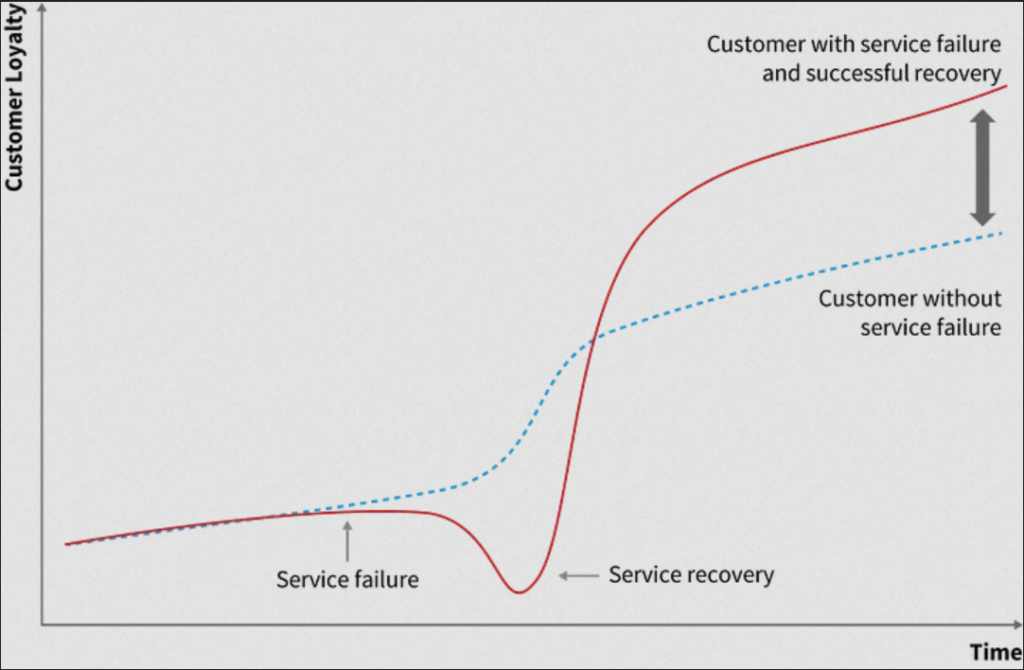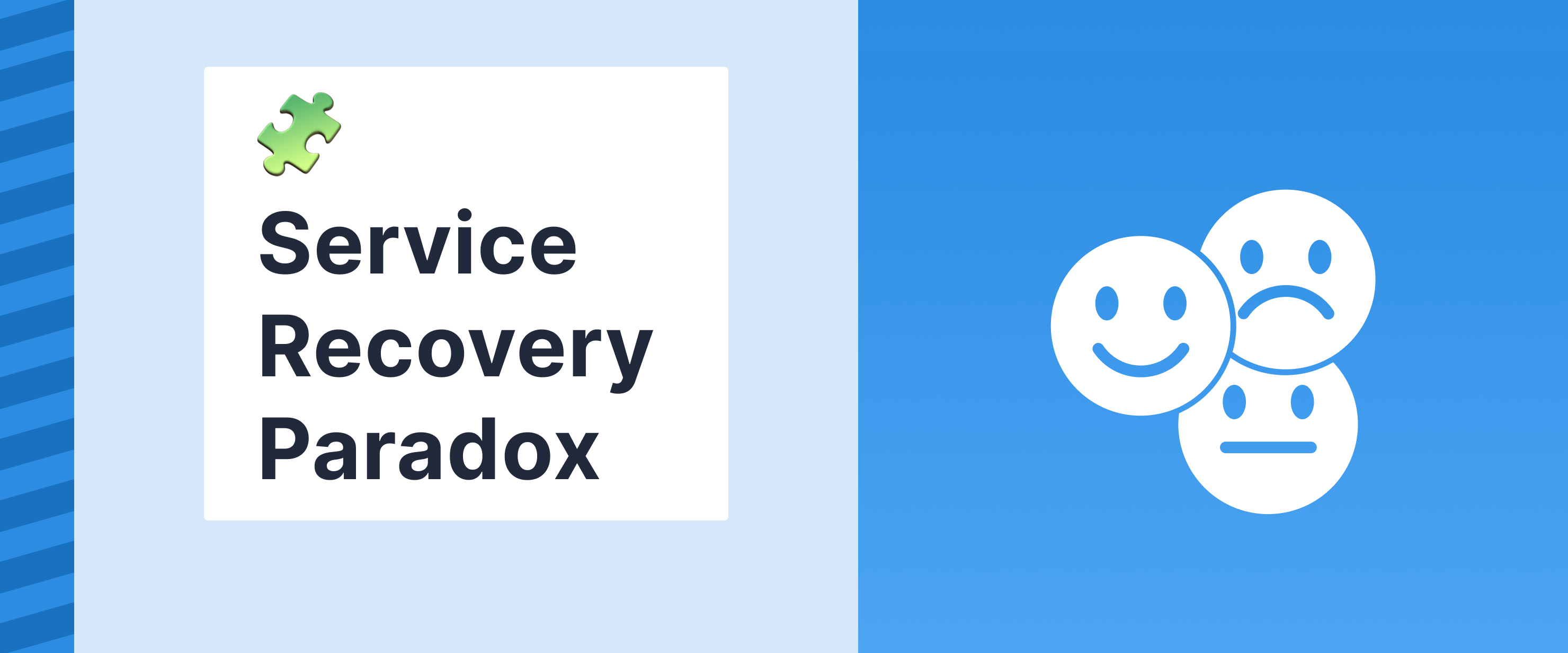Table of Contents
In the relentless race for customer loyalty, a company’s true test is not in its ability to avoid mistakes but in how it handles them when they inevitably occur. There’s a surprising twist in the story of customer service: sometimes, a well-managed setback can leave a customer even more satisfied than if everything had gone perfectly.
Imagine a customer receiving the wrong item in an online order. Frustration is the first reaction, naturally. However, if the company responds quickly with a heartfelt apology and a little extra, like a discount or a gift, the customer might actually be more impressed than before.
This counterintuitive concept, known as the service recovery paradox, challenges businesses to rethink their approach to customer service. In this article, we’ll explore the mechanics behind this paradox, what it means for customer loyalty and how it can help your business grow.
Key Takeaways
- The service recovery paradox occurs when a customer ends up more satisfied after a well-handled service failure than if nothing had gone wrong, highlighting the importance of turning setbacks into loyalty opportunities.
- Successful recoveries focus on empathy, fair treatment and memorable interactions to enhance customer satisfaction.
- To capitalize on service failures, businesses should act quickly, be transparent, exceed expectations and foster a culture of exceptional service.
- While effective, the service recovery paradox has its challenges. Companies must balance recovery strategies with preventative measures to minimize service failures.
What is the Service Recovery Paradox?
The service recovery paradox is a concept that flips traditional customer service wisdom. It suggests that a customer may end up more satisfied and loyal after experiencing a service failure if followed by an exceptional recovery effort. This paradox hinges on the idea that an effective recovery can show a company’s commitment to its customers, potentially turning a negative experience into a memorable one.
“If there is a positive disconfirmation, that is, if perceptions of service recovery performance are greater than expectations, a paradox might emerge (secondary satisfaction becomes greater than prefailure satisfaction). Otherwise, in the case of a negative disconfirmation, there is a double negative effect, as service failure is followed by a flawed recovery.” (Celso Augusto de Matos, Jorge Luiz Henrique and Carlos Alberto Vargas Rossi Research)
The following graph illustrates this concept and tracks the trajectory of customer loyalty over time.

For the service recovery paradox to take effect, two critical conditions must be met:
- Isolated Incident: The service failure must be perceived as a one-time issue, not indicative of the company’s usual standards.
- Exceeding Expectations: The recovery must not just resolve the issue but go beyond customer expectations with swift action, genuine empathy and a meaningful gesture of goodwill.
By mastering recovery, businesses can transform setbacks into opportunities, proving that how they respond to mistakes can matter more than avoiding them altogether.
Psychological Mechanisms Behind the Paradox
The service recovery paradox is a great example of how human psychology shapes our reactions to service failures. When things go wrong, we naturally feel disappointed. However, a company can turn this negative experience around and leave us feeling even more satisfied than before. This happens when businesses handle the situation in a way that feels fair, thoughtful, and respectful.
Psychologists refer to this as “perceived justice“, which involves three main areas:
- Outcome Fairness: Was the problem resolved in a way that seems fair to you?
- Process Fairness: Was the issue handled quickly and efficiently?
- Interaction Fairness: Were you treated kindly and with empathy?
When companies get these things right, they show care about their customers, which can turn a mistake into a chance to impress.
There’s also the principle of reciprocity – the idea that when someone does something nice for us, we naturally want to return the favor. If a company goes above and beyond to fix a problem, customers often respond with increased loyalty and positive word-of-mouth.
Lastly, there’s something known as the “peak-end rule“, which suggests we remember experiences based on the most intense moment and how they end. So, if a company turns a bad situation into a positive one, the last thing you remember is how well they handled it, leaving you with a better overall impression.
Together, these insights explain why a well-managed recovery can actually enhance customer satisfaction and loyalty, proving that even a bump in the road can be an opportunity for companies to shine.
Implications for Customer Loyalty and Business Growth
When companies effectively manage service failures, they can turn negative experiences into opportunities to strengthen customer relationships. According to Salesforce Research, 78% of customers who receive satisfactory resolutions remain loyal, leading to repeat business and positive word-of-mouth – both vital for growth.
In a market where customer experience is a key differentiator, companies known for exceptional service recovery gain a competitive edge. With 73% of consumers influenced by a positive experience in their brand loyalty, the importance of customer experience in shaping consumer preferences and fostering long-term relationships is clear.
The financial benefits are also significant: loyal customers spend more and are less price-sensitive. Harvard Business Review notes that acquiring new customers can be five to 25 times more expensive than retaining existing ones. Moreover, a Bain & Company study found that customers with great experiences spend 140% more, so it’s worth going the extra mile.
7 Proven Strategies to Win Back Customer Trust After Service Failures
With the right recovery strategies, companies can not only resolve issues but also strengthen relationships. Here are seven tips to turn setbacks into loyalty-building opportunities:
- Prioritize Flexibility Over Process: Following procedures can sometimes get in the way of effective communication. To impress your customers, you need to offer more than what’s expected. If an issue occurs outside of regular business hours, make sure someone is ready to jump in and help. Customers value responsiveness and appreciate companies that go the extra mile to address their concerns, even if it means working overtime.
- Connect Quickly and Show Care: Rather than viewing customer complaints as a burden, think of them as opportunities to strengthen your relationship. Customers want to feel valued and understood. Engage with them promptly and show genuine empathy in your interactions. Quick, caring and proactive action can turn a negative experience into a loyalty-building moment.
- Be Open and Honest: Build trust by being upfront about the service failure. Explain what happened and how you plan to fix it. Transparency goes a long way, and customers appreciate honesty and accountability. Studies show that 94% of consumers are likely to be loyal to a brand that offers complete transparency.
- Empower Your Team: Your frontline employees are your best bet for turning things around quickly. They’re the ones who can fix problems on the spot, so give them the authority and tools they need to make customers happy. Training them to think on their feet and understand the whole service process can make a huge difference.
- Customize Recovery Solutions: A one-size-fits-all approach to service recovery doesn’t always work, as no two customers are the same. To fully leverage the service recovery paradox, tailor your recovery efforts to each individual customer. This involves understanding their specific needs and preferences to create more meaningful experiences.
- Learn from Mistakes: After resolving the issue, take some time to analyze what went wrong and share your findings with the customer. Let them know how you’re making sure it doesn’t happen again. This shows that you’re committed to getting better and being accountable.
- Foster a Customer-First Culture: Service recovery shouldn’t just be an afterthought but part of your overall strategy. Encourage your team to view every customer interaction as an opportunity to build trust and create positive experiences. By embedding SRP into this customer-first approach and consistently gathering feedback, your business can deliver great service at every touchpoint and build a more resilient customer base.
Challenges and Limitations
While the service recovery paradox can be a powerful tool for building customer loyalty, it comes with several challenges and limitations:
- Inconsistency in Results: The service recovery paradox does not guarantee success in every situation. For it to work, the failure must be seen as a one-time thing and the recovery effort must really exceed customer expectations. For example, if a restaurant keeps serving cold food but offers free desserts as an apology, customers might appreciate it at first. However, ongoing failures could frustrate them in the long run, making them take their business elsewhere.
- Risk of Complacency: Companies might get too comfortable with fixing problems and neglect the root causes. Imagine a hotel chain that focuses on apologizing and offering free upgrades when issues arise, rather than fixing the booking system. This approach may prevent them from making the necessary improvements.
- Increased Operational Costs: Effective service recovery often involves compensation or extra services, which can increase operational costs and reduce profits, especially if done frequently. Consider a tech company that regularly sends replacement devices to resolve complaints. While this may satisfy customers initially, the replacement costs could hurt the company’s bottom line.
- Potential Customer Skepticism: Not all customers will respond positively to recovery efforts. Some might still be unhappy or skeptical about the company’s reliability. Building trust requires consistency, and over time, repeated failures can damage a brand’s reputation. For instance, if an airline frequently cancels flights but offers vouchers as compensation, customers might start doubting the airline’s reliability and avoid flying with them in the future. The service recovery paradox is also more likely to succeed with loyal customers, who are more forgiving, whereas those with weaker connections may not be as easily won over.
- Inconsistent Recovery Efforts: Variability in how service recovery is handled can lead to further dissatisfaction if not managed properly. Companies must standardize recovery processes and ensure that employees are well-trained to handle issues effectively. For example, take a retail store where one customer receives a full refund for a defective product, while another is only offered store credit for a similar issue. Such inconsistencies can lead to dissatisfaction and perceptions of unfair treatment.
To avoid these challenges, companies should balance effective service recovery with proactive measures to reduce service failures and continuously improve their processes.
Turning Failures into Loyalty: The Final Word
With more options than ever, customers aren’t shy about switching to a competitor after a bad experience. This makes the way you handle mistakes incredibly important. Understanding and leveraging the service recovery paradox can turn a potential disaster into an opportunity to build stronger, more loyal customer relationships. It’s not just about fixing the problem, but showing customers that you care enough to go the extra mile when things don’t go as planned.
Understanding the psychology behind SRP and knowing when and how to apply it can boost customer satisfaction and loyalty, even in the face of service failures. However, relying too heavily on the service recovery paradox has its risks. It’s important to balance recovery efforts with a proactive approach to prevent issues from occurring in the first place.
To do this effectively, collecting customer feedback is a must. CX surveys help you identify where service may have fallen short and allow you to tailor recovery efforts that truly speak to customers.
Ready to turn your service challenges into opportunities for success? Start with a free trial or book a demo call with us today to see how Retently can help you enhance your customer experience and drive growth.






























 Greg Raileanu
Greg Raileanu 


 Alex Bitca
Alex Bitca 


 Christina Sol
Christina Sol